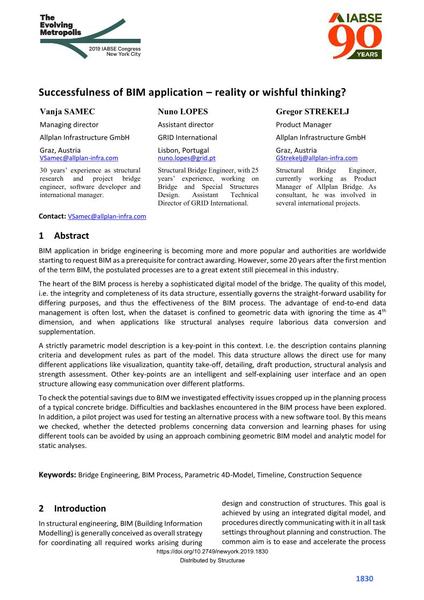Successfulness of BIM application – reality or wishful thinking?

|
|
|||||||||||
Bibliographic Details
| Author(s): |
Vanja Samec
(Allplan Infrastructure GmbH)
Nuno Lopes (GRID International) Gregor Strekelj (Allplan Infrastructure GmbH) |
||||
|---|---|---|---|---|---|
| Medium: | conference paper | ||||
| Language(s): | English | ||||
| Conference: | IABSE Congress: The Evolving Metropolis, New York, NY, USA, 4-6 September 2019 | ||||
| Published in: | The Evolving Metropolis | ||||
|
|||||
| Page(s): | 1830-1835 | ||||
| Total no. of pages: | 6 | ||||
| DOI: | 10.2749/newyork.2019.1830 | ||||
| Abstract: |
BIM application in bridge engineering is becoming more and more popular and authorities are worldwide starting to request BIM as a prerequisite for contract awarding. However, some 20 years after the first mention of the term BIM, the postulated processes are to a great extent still piecemeal in this industry. The heart of the BIM process is hereby a sophisticated digital model of the bridge. The quality of this model, i.e. the integrity and completeness of its data structure, essentially governs the straight-forward usability for differing purposes, and thus the effectiveness of the BIM process. The advantage of end-to-end data management is often lost, when the dataset is confined to geometric data with ignoring the time as 4thdimension, and when applications like structural analyses require laborious data conversion and supplementation. A strictly parametric model description is a key-point in this context. I.e. the description contains planning criteria and development rules as part of the model. This data structure allows the direct use for many different applications like visualization, quantity take-off, detailing, draft production, structural analysis and strength assessment. Other key-points are an intelligent and self-explaining user interface and an open structure allowing easy communication over different platforms. To check the potential savings due to BIM we investigated effectivity issues cropped up in the planning process of a typical concrete bridge. Difficulties and backlashes encountered in the BIM process have been explored. In addition, a pilot project was used for testing an alternative process with a new software tool. By this means we checked, whether the detected problems concerning data conversion and learning phases for using different tools can be avoided by using an approach combining geometric BIM model and analytic model for static analyses. |
||||
| Keywords: |
bridge engineering Construction sequence BIM Process Parametric 4D-Model timeline
|
||||
